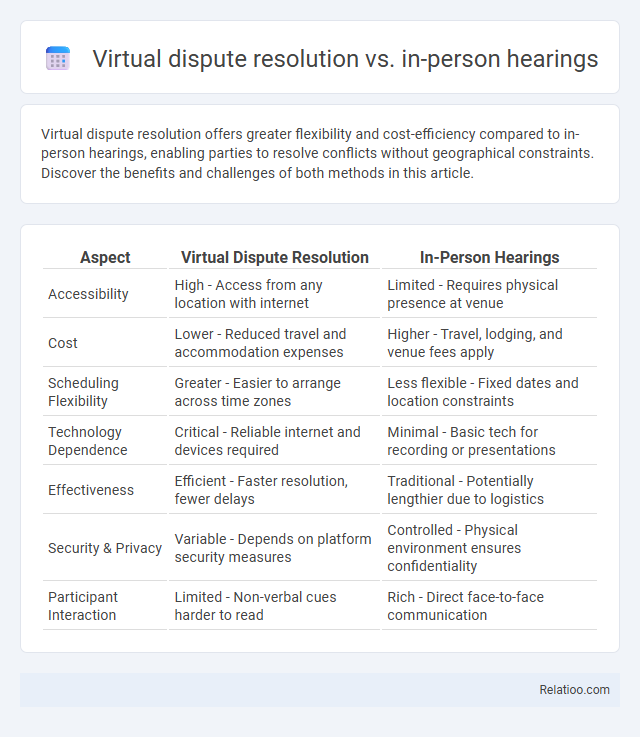Virtual dispute resolution offers greater flexibility and cost-efficiency compared to in-person hearings, enabling parties to resolve conflicts without geographical constraints. Discover the benefits and challenges of both methods in this article.
Table of Comparison
| Aspect | Virtual Dispute Resolution | In-Person Hearings |
|---|---|---|
| Accessibility | High - Access from any location with internet | Limited - Requires physical presence at venue |
| Cost | Lower - Reduced travel and accommodation expenses | Higher - Travel, lodging, and venue fees apply |
| Scheduling Flexibility | Greater - Easier to arrange across time zones | Less flexible - Fixed dates and location constraints |
| Technology Dependence | Critical - Reliable internet and devices required | Minimal - Basic tech for recording or presentations |
| Effectiveness | Efficient - Faster resolution, fewer delays | Traditional - Potentially lengthier due to logistics |
| Security & Privacy | Variable - Depends on platform security measures | Controlled - Physical environment ensures confidentiality |
| Participant Interaction | Limited - Non-verbal cues harder to read | Rich - Direct face-to-face communication |
Understanding Virtual Dispute Resolution
Virtual dispute resolution leverages digital platforms to facilitate negotiations, mediations, and hearings, offering flexibility and accessibility compared to traditional in-person hearings. Your ability to participate remotely reduces logistical challenges and expedites the resolution process by enabling real-time communication without geographical constraints. Understanding virtual dispute resolution helps you navigate modern conflict management efficiently while maintaining the integrity and enforceability of dispute outcomes.
Key Features of In-Person Hearings
In-person hearings offer direct, real-time interaction, allowing for immediate assessment of witness credibility through body language and tone. Your ability to observe non-verbal cues and engage in spontaneous questioning enhances the depth of dispute resolution. These hearings provide a structured environment with formal procedures, fostering transparency and ensuring that all parties have equal opportunity to present evidence and arguments.
Accessibility and Convenience Comparison
Virtual dispute resolution offers enhanced accessibility by enabling participants to join hearings from any location with internet access, reducing travel time and related costs. In-person hearings provide a traditional setting that may benefit parties needing face-to-face interaction but often involve logistical challenges, such as scheduling conflicts and travel requirements. Compared to typical dispute processes, virtual platforms increase convenience by allowing flexible scheduling and quicker case management, which leads to faster resolution times and broader participation.
Cost Implications: Virtual vs In-Person
Virtual dispute resolution significantly reduces costs by eliminating travel expenses, venue fees, and related logistical charges associated with in-person hearings. Your organization can save on administrative overhead and time lost during physical meetings, leading to increased efficiency and lower overall legal expenditure. However, certain complex disputes might still require in-person hearings to ensure thorough deliberation despite higher costs.
Security and Confidentiality Concerns
Virtual dispute resolution platforms utilize advanced encryption protocols and secure digital channels to protect sensitive information, significantly reducing risks associated with data breaches compared to traditional in-person hearings. In-person hearings require physical security measures but may face vulnerabilities such as unauthorized recordings and manual document handling errors, potentially compromising confidentiality. Dispute resolution processes must prioritize robust security frameworks tailored to the chosen method to ensure privacy, safeguard evidence integrity, and maintain participant trust throughout the resolution process.
Effectiveness in Resolving Disputes
Virtual dispute resolution offers increased accessibility and convenience, reducing time and costs associated with travel and scheduling conflicts. In-person hearings facilitate more nuanced communication and the ability to gauge non-verbal cues, often enhancing the depth of understanding between parties. Your choice between virtual and in-person methods should consider the complexity of the dispute and the importance of direct interaction for achieving effective resolution.
Impact on Participant Engagement
Virtual dispute resolution enhances participant engagement by offering flexibility and the comfort of familiar environments, which can reduce stress and increase attentiveness. In-person hearings provide direct human interaction and non-verbal cues that foster clearer communication and trust among parties. Your choice between these methods significantly impacts the effectiveness of dispute resolution by influencing how actively and comfortably participants engage throughout the process.
Technology Requirements and Barriers
Virtual dispute resolution relies heavily on stable internet connections, secure communication platforms, and user-friendly interfaces, which can pose significant technology barriers for participants lacking digital literacy or access to advanced devices. In-person hearings minimize technological requirements but increase costs and logistical challenges like travel and scheduling, which can delay the resolution process. Your ability to effectively participate in any dispute resolution method depends on overcoming these technology hurdles and ensuring all parties have equitable access to necessary tools.
Adapting Legal Procedures for Each Format
Adapting legal procedures for virtual dispute resolution requires optimizing technology integration, ensuring secure and confidential communication platforms, and streamlining evidence presentation for digital formats. In contrast, in-person hearings benefit from direct interaction and non-verbal cues, necessitating protocols that manage physical courtroom logistics and maintain procedural integrity. Dispute resolution frameworks must flexibly accommodate these differences, balancing efficiency, fairness, and accessibility across both virtual and traditional methods.
Future Trends in Dispute Resolution Methods
Virtual dispute resolution is rapidly advancing with AI integration and blockchain for enhanced transparency and efficiency, outpacing traditional in-person hearings in accessibility and cost-effectiveness. Hybrid dispute resolution models combining virtual and in-person elements are emerging to accommodate diverse participant needs and ensure fairness. Future trends emphasize automation, predictive analytics, and increased reliance on online platforms to streamline dispute resolution processes across sectors.

Infographic: Virtual dispute resolution vs in-person hearings
 relatioo.com
relatioo.com